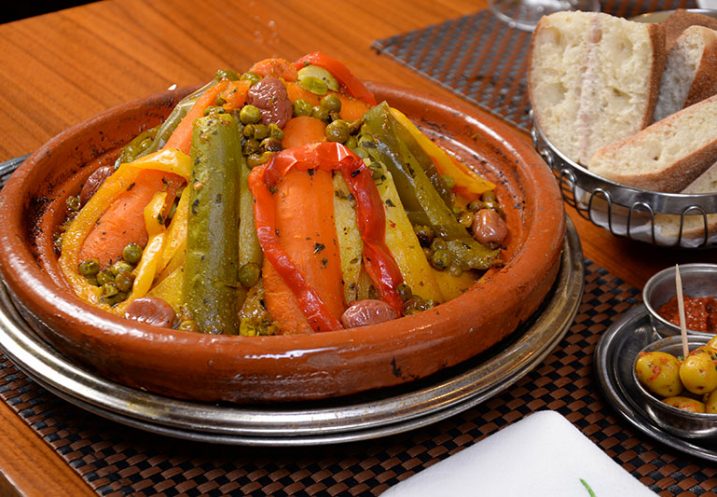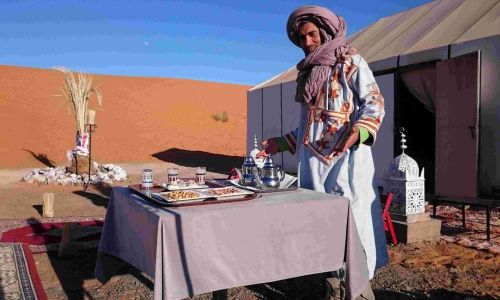MOROCCAN CHICKEN TAGINE RECIPE
If there is a popular dish in Moroccan cuisine this is the tagine. Tagine is not the name of a dish but the name of the cooking container used to cook many different recipes. In this article, we are gonna give you all you need to know about the Moroccan tajine and teach you to cook the popular Moroccan chicken tajine recipe that is usually cooked in the Moroccan Sahara desert.
What is a tagine and how to prepare it so that it is ready to cook
As we said, a tagine is a container for cooking made of terracotta, consisting of a bowl and a conical lid. In addition to the container, the stew that is prepared in it is also called tajine, in the same way, that cauldrons, paellas, and other kitchen utensils are called, which also gives their name to the dishes prepared in them.
Moroccan tagine recipes
The cuisine in the Tajine is characteristic of Morocco, and other Maghreb countries. It is characterized by very slow cooking, originated by the design of the tajine, which allows to distribute the heat by its interior of efficient form, with a smaller power expense.
The conical lid makes the water steam that originates in the cooking, remain inside the container so that the food remains in contact with the steam and thus, better preserves its properties and main organoleptic characteristics.
Furthermore, as the clay is a container that can withstand a lot of heat after the food has been prepared if it is kept inside the tajine with the lid on, it can withstand the serving temperature for a long time. For this reason, the tajine is also very interesting in terms of reducing energy consumption.
What exactly is a tagine?
The tajine, which for most of us refers to excellent Moroccan culinary specialties based on fish, meat, poultry, or stewed vegetables, is above all the name given to the traditional Berber cooking utensils in which they are simmered.
The tajine is a hollow terracotta dish, covered with a conical lid, which allows the food to be steamed while preserving its flavors and benefits. After marinating in a subtle mixture of spices and herbs, the meat – or fish – is placed at the bottom of the plate and covered with vegetables and a little water. Once closed, the tagine is placed directly on the brazier, a terracotta fireplace containing the charcoal.
Otherwise, the tagine can be placed on the charcoal barbecue, but not in direct contact with the flame, on the gas (plate, barbecue…), or the induction plate, with a diffuser. The dish is cooked like this, initially over a moderate heat because the embers are hot, then gradually over a softer heat, between 1 and 2 hours depending on the ingredients. The brazier normally contains the necessary coal for the cooking time.
The different tagines
Among the traditional tajines, the Chamali, made of unglazed terracotta, is suitable for simmering. On the other hand, brown glazed tagines, such as the Slaoui and some models with glazed motifs, are undoubtedly the most resistant and least expensive. They are suitable for all preparations and all types of cooking.
Tagine-manufacturing
In addition to the kitchen tajines, there are also glazed models, enhanced with enameled trimmings, which are only intended to serve hot dishes such as Sfioui or Fassi, or even just for decoration. Therefore, it is necessary to ask before buying.
How to cure a tagine before cooking
A tajine, like any other clay container, needs a preparation process before it is used for the first time. The reason for this is to ensure that it can be used many times, without the temperature changes caused by cooking cracking it or causing it to break.
This process applies to any other casserole or clay dish that we can acquire at a market, and it includes some popular techniques, which will ensure that our pot will last much longer. This process is called curing, and there are different ways to do it.
Of course, in the case of modern tagine today, which is made of porcelain glazed ceramic, or even silicone, it is not necessary to do this process, but if we have some raw clay pot without being glazed, these techniques will be very useful to leave our casseroles ready for use.
Immersion in water and baking
The most recommended way is to leave the tajine submerged in water for six or eight hours, or if you prefer, leave it covered with water overnight. After that time, throw the water away and spread it whole with olive oil. This should be done with both the container and the conical lid.
Once spread, put it in the oven (without preheating) and put it at 160º, letting it bake for an hour. Then turn off the oven and let the tajine cool down inside. And it is ready to use.

Other popular techniques for curing clay pots
Another technique to cure the tajine is a variant of the previous one, consisting of rubbing the tajine with a garlic clove, both outside and inside, after having left the tajine or the clay pot submerged in water, for one night. Afterward, it must be filled again with water and brought to a boil.
Finally, another extended technique is to first smear the entire surface with garlic, then varnish it with a brush dipped in egg white and let it dry on the clay. Finally, the tajine or pot is filled with milk and brought to a boil. Once the process is finished, the pot is washed well and is ready to use.
In addition to the kitchen tajines, there are also glazed models, enhanced with enameled trimmings, which are only intended to serve hot dishes such as Sfioui or Fassi, or even just for decoration. Therefore, it is necessary to ask before buying.
Finally, another extended technique is to first smear the entire surface with garlic, then varnish it with a brush dipped in egg white and let it dry on the clay. Finally, the tajine or pot is filled with milk and brought to a boil. Once the process is finished, the pot is washed well and is ready to use.
Tagine is an emblematic dish of Maghreb cuisine, especially in Morocco. It is originally a Berber dish: a kind of stew, in which vegetables and meat are cooked in a stew.
The word tajine refers to the terracotta dish in which the food is cooked. The pointed shape of the lid has been designed to allow cooking without water, thus preserving all the flavors of the food. The steam from the food condenses on the lid of the tagine plate and then falls back onto the food, which is then moistened.
Multiple possibilities
The word tagine, when referring to food, therefore refers to the food that has been cooked in the tagine dish. There are a large number of different tagines, containing meat, vegetables, and fruits (there are many sweet and savory recipes in Moroccan cuisine: tagines with olives, quince, figs, dates, or apricots), all with beef, lamb, or chicken: there really is something for everyone! There are even vegetarian tagine recipes, like this recipe for vegetable tagines with olives.
Now that you know everything about this dish (or rather about this cooking technique, which is then divided into multiple recipes and flavors), we’re curious to find out which of these tajine recipes to let you cook tonight. It’s normal, to talk about good things, that’s fine!
Choosing a Moroccan tagine
A handmade product, the tagine must be carefully examined when you buy it. The slightest defect would be fatal during cooking. The dish must be resistant and have no cracks. The lid must rest correctly on the plate and have a small hole to evacuate the steam.
Before using the Tagine for the first time, it is essential to waterproof it. To do this, simply soak it overnight in cold water and then let it dry. Then cover it with oil. You can also pour a small glass of olive oil with possibly a sprig of thyme, which is then left to simmer for about five minutes. Covered in this way, the tagine is more resistant to thermal shocks, does not crack when first used, does not cling too tightly, and is easier to wash.
Moroccan tagine recipes
The tagine allows multiple possibilities, from a simple lamb omelet to dates, the tagine allows you to give free rein to your imagination and the contents of your cabinets: tomatoes, onions, peppers, candied lemons, nuts, chicken wings, thighs, meatballs, eggs, red mullet fillets… The principle is always the same: heat oil, fry onions and vegetables, add spices, herbs, colorings, a little water to prevent them from sticking, and then possibly meat, fish, or eggs.
How to cook in a Tagine and what to keep in mind
Before commenting on some recipes cooked in a tajine or tayin we will give some brief clues on how to cook in a tajine:
1. The cooking temperature
Clay, the material of which a tajine is made, cannot withstand very high temperatures for a long period: For this reason, the first thing to consider is that it must be cooked over low or medium heat to prevent the container from cracking
2. The amount of liquid used for cooking
First, you have to put the base or plate on medium heat until it gets hot. To enhance the flavor of the meat in our stew we can seal it first in the tajine to enhance the flavour of the proteins. It is important not to overload ourselves with the liquid we add as the tajine does not allow it to evaporate. The best technique is to add water or broth little by little.
3. The arrangement of the food
Foods that need to be cooked for a long time, such as potatoes or carrots, should be placed on top of the tajine, with the most tender foods placed on top. The Moroccans have the technique very studied and they place the foods in the form of a pyramid. In this way, the harder foods will have more contact with the liquid and will be cooked earlier. We will put the meats on the top of the tajine so that they are steamed and gain in juiciness. Finally, the tajine is covered and cooked for two, three, or four hours, depending on the hardness of the meat.
4. The residual heat of the tagine
The material with which this Moroccan container is made, clay, keeps the heat very well, so after preparing the food and even if we turn off the fire, the preparation will stay hot for quite some time inside and will be a great advantage for the moment of service as well as a notable reduction in energy consumption.
The idea is to cut small pieces to encourage short cooking. Because, for Moroccan women, the tagine allows them to invite friends who have come to have an unexpected appetizer.
Moroccan chicken tagine recipe
Ingredients
- 1kg of lamb
- 3 red onions
- 3 potatoes
- 2 carrots
- 2 turnips
- 2 tomatoes
- 2 zucchini
- 1 teaspoon ginger
- 1 teaspoon hot pepper
- 1 dose of Saffron
- the peel of 2 candied lemons
- a drizzle of olive oil
- candied green olives
- salt, pepper
Preparation
The Berber Tagine is the traditional Moroccan chicken tagine, a dish with the flavors of the atlas. On the meat side, you can choose lamb, veal, or chicken, you can also do without.
As for the quantity of vegetables, it’s up to each person’s taste, you can put more or less of this or that vegetable.
In a tagine, brown the pieces of meat in a drizzle of olive oil with finely chopped onion. Season with hot pepper, pepper, ginger, saffron and salt. Sprinkle with water and leave to cook for 45 minutes.
In the meantime wash the vegetables, and peel them. Slice the onions into rings, cut the potatoes lengthwise, cut the courgettes into quarters lengthwise, the carrots and the turnips.
Arrange the vegetables in the shape of a dome on the meat, sprinkle with a drizzle of olive oil, and leave to cook for 30 minutes on a very low heat.
Serve hot in the tagine dish.
DISCOVER OUR TOURS TO SAHARA DESERT IN MOROCCO

FROM MARRAKECH
Our most popular Morocco Sahara Tours . The trip from Marrakech is rich in scenery and includes an unforgettable stay in a Desert Camp.

FROM FES
A great experience starting from Fes including camel trekking and at least one night in a tented desert camp in the Merzouga Desert.

CUSTOM TOURS
Our experts can create exceptional tailor-made experiences for our clients. Contact us and we´ll plan your perfect trip in Morocco.
